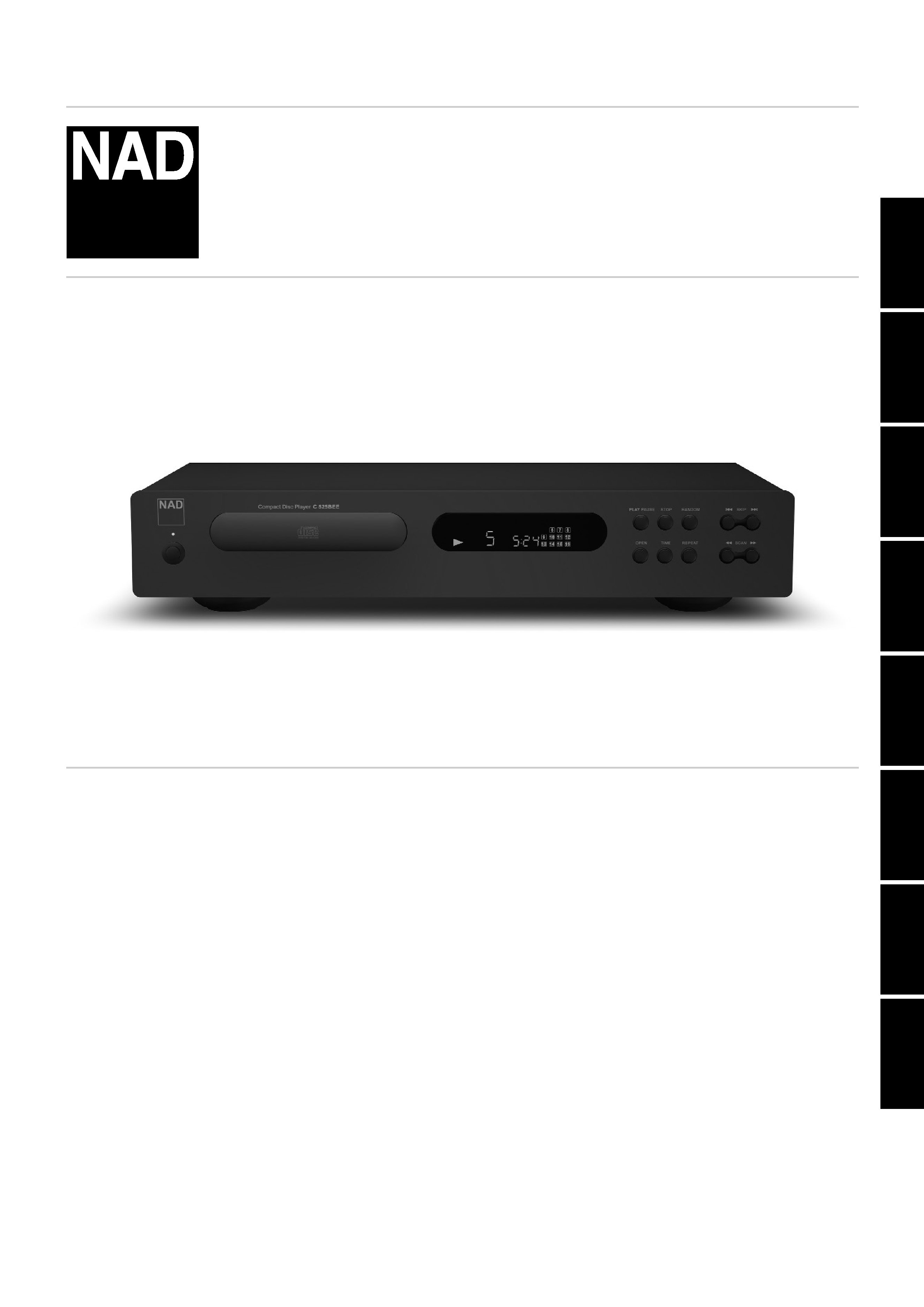
Compact Disc Player
ENGLISH
FRANÇAIS
DEUTSCH
NEDERLANDS
ESP
AÑOL
IT
ALIANO
POR
TUGUÊS
SVENSKA
Owner's Manual
Manuel d'Installation
Bedienungsanleitung
Gebruikershandleiding
Manual del Usuario
Manuale delle Istruzioni
Manual do Proprietário
Bruksanvisning
®
C 525BEE
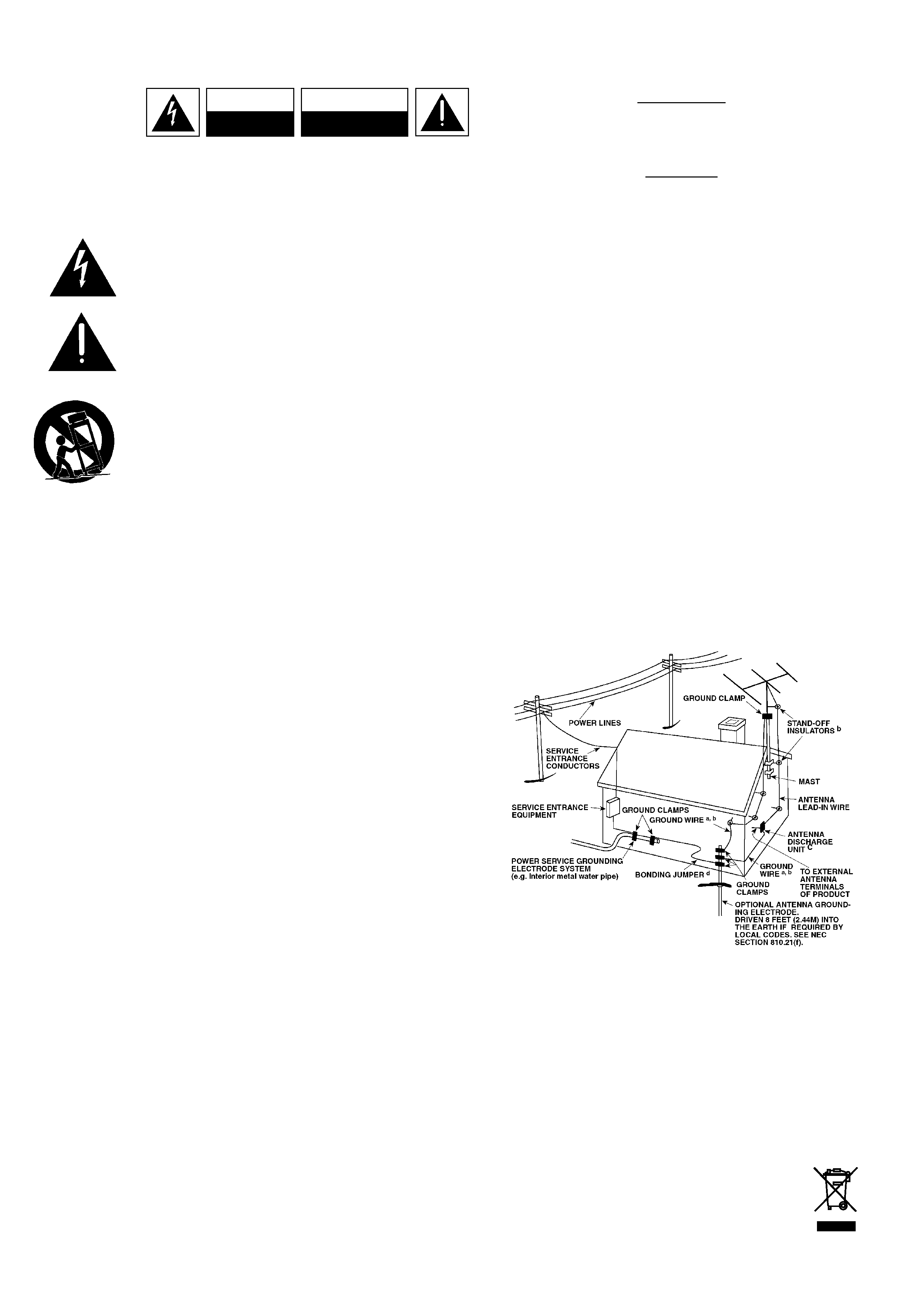
Warning: To reduce the risk of fire or electric shock, do not
expose this unit to rain or moisture.
The lightning flash with an arrowhead symbol within an equilateral
triangle, is intended to alert the user to the presence of uninsulated
"dangerous voltage" within the product's enclosure that may be of
sufficient magnitude to constitute a risk of electric shock to persons.
The exclamation point within an equilateral triangle is intended to
alert the user to the presence of important operating and
maintenance (servicing) instructions in the literature accompanying
the product.
Do not place this unit on an unstable cart, stand or tripod, bracket
or table. The unit may fall, causing serious injury to a child or adult
and serious damage to the unit. Use only with a cart, stand, tripod,
bracket or table recommended by the manufacturer or sold with
the unit. Any mounting of the device on a wall or ceiling should
follow the manufacturer's instructions and should use a mounting
accessory recommended by the manufacturer.
An appliance and cart combination should be moved with care.
Quick stops, excessive force and uneven surfaces may cause the
appliance and cart combination to overturn.
Read and follow all the safety and operating instructions before
connecting or using this unit. Retain this notice and the owner's
manual for future reference.
All warnings on the unit and in its operating instructions should be
adhered to.
Do not use this unit near water; for example, near a bath tub,
washbowl, kitchen sink, laundry tub, in a wet basement or near a
swimming pool.
The unit should be installed so that its location or position does not
interfere with its proper ventilation. For example, it should not be
situated on a bed, sofa, rug or similar surface that may block the
ventilation openings; or placed in a built-in installation, such as a
bookcase or cabinet, that may impede the flow of air through its
ventilation openings.
The unit should be situated from heat sources such as radiators,
heat registers, stoves or other devices (including amplifiers) that
produce heat.
The unit should be connected to a power supply outlet only of the
voltage and frequency marked on its rear panel.
The power supply cord should be routed so that it is not likely to be
walked on or pinched, especially near the plug, convenience
receptacles, or where the cord exits from the unit.
Unplug the unit from the wall outlet before cleaning. Never use
benzine, thinner or other solvents for cleaning. Use only a soft
damp cloth.
The power supply cord of the unit should be unplugged from the
wall outlet when it is to be unused for a long period of time.
Care should be taken so that objects do not fall, and liquids are not
spilled into the enclosure through any openings.
This unit should be serviced by qualified service personnel when:
A. The power cord or the plug has been damaged; or
B. Objects have fallen, or liquid has been spilled into the unit; or
C. The unit has been exposed to rain or liquids of any kind; or
D. The unit does not appear to operate normally or exhibits a
marked change in performance; or
E. The device has been dropped or the enclosure damaged.
DO NOT ATTEMPT SERVICING OF THIS UNIT
YOURSELF. REFER SERVICING TO QUALIFIED
SERVICE PERSONNEL
Upon completion of any servicing or repairs, request the service
shop's assurance that only Factory Authorized Replacement Parts
with the same characteristics as the original parts have been used,
and that the routine safety checks have been performed to
guarantee that the equipment is in safe operating condition.
REPLACEMENT WITH UNAUTHORIZED PARTS MAY RESULT IN FIRE,
ELECTRIC SHOCK OR OTHER HAZARDS.
ATTENTION
POUR ÉVITER LES CHOC ELECTRIQUES, INTRODUIRE LA
LAME LA PLUS LARGE DE LA FICHE DANS LA BORNE
CORRESPONDANTE DE LA PRISE ET POUSSER JUSQU'AU
FOND.
CAUTION
TO PREVENT ELECTRIC SHOCK, MATCH WIDE BLADE OF
PLUG TO WIDE SLOT FULLY INSERT.
If an indoor antenna is used (either built into the set or installed
separately), never allow any part of the antenna to touch the metal
parts of other electrical appliances such as a lamp, TV set etc.
CAUTION
POWER LINES
Any outdoor antenna must be located away from all power lines.
OUTDOOR ANTENNA GROUNDING
If an outside antenna is connected to your tuner or tuner-
preamplifier, be sure the antenna system is grounded so as to
provide some protection against voltage surges and built-up static
charges. Article 810 of the National Electrical Code, ANSI/NFPA No.
70-1984, provides information with respect to proper grounding of
the mast and supporting structure, grounding of the lead-in wire to
an antenna discharge unit, size of grounding conductors, location of
antenna discharge unit, connection to grounding electrodes and
requirements for the grounding electrode.
a. Use No. 10 AWG (5.3mm2) copper, No. 8 AWG (8.4mm2)
aluminium, No. 17 AWG (1.0mm2) copper-clad steel or bronze
wire, or larger, as a ground wire.
b. Secure antenna lead-in and ground wires to house with stand-off
insulators spaced from 4-6 feet (1.22 - 1.83 m) apart.
c. Mount antenna discharge unit as close as possible to where lead-
in enters house.
d. Use jumper wire not smaller than No.6 AWG (13.3mm2) copper,
or the equivalent, when a separate antenna-grounding electrode
is used. see NEC Section 810-21 (j).
EXAMPLE OF ANTENNA GROUNDING AS PER NATIONAL ELECTRICAL
CODE INSTRUCTIONS CONTAINED IN ARTICLE 810 - RADIO AND
TELEVISION EQUIPMENT.
NOTE TO CATV SYSTEM INSTALLER: This reminder is provided to
call the CATV system installer's attention to Article 820-40 of the
National Electrical Code that provides guidelines for proper
grounding and, in particular, specifies that the ground cable ground
shall be connected to the grounding system of the building, as close
to the point of cable entry as practical.
CAUTION
RISK OF ELECTRIC
SHOCK DO NOT OPEN
ATTENTION:
RISQUE DE CHOC ELECTRIQUE
NE PAS OUVRIR
CAUTION: TO REDUCE THE RISK OF ELECTRIC
SHOCK, DO NOT REMOVE COVER (OR BACK). NO
USER SERVICEABLE PARTS INSIDE. REFER SERVICING
TO QUALIFIED SERVICE PERSONNEL.
IMPORTANT SAFETY INSTRUCTIONS
2
NOTES ON ENVIRONMENTAL PROTECTION
At the end of its useful life, this product must not be disposed of
with regular household waste but must be returned to a collection
point for the recycling of electrical and electronic equipment. The
symbol on the product, user's manual and packaging, point this out.
The materials can be reused in accordance with their markings.
Through re-use, recycling of raw materials, or other forms of recycling
of old products, you are making an important contribution to the
protection of our environment.
Your local administrative office can advise you of the
responsible waste disposal point.
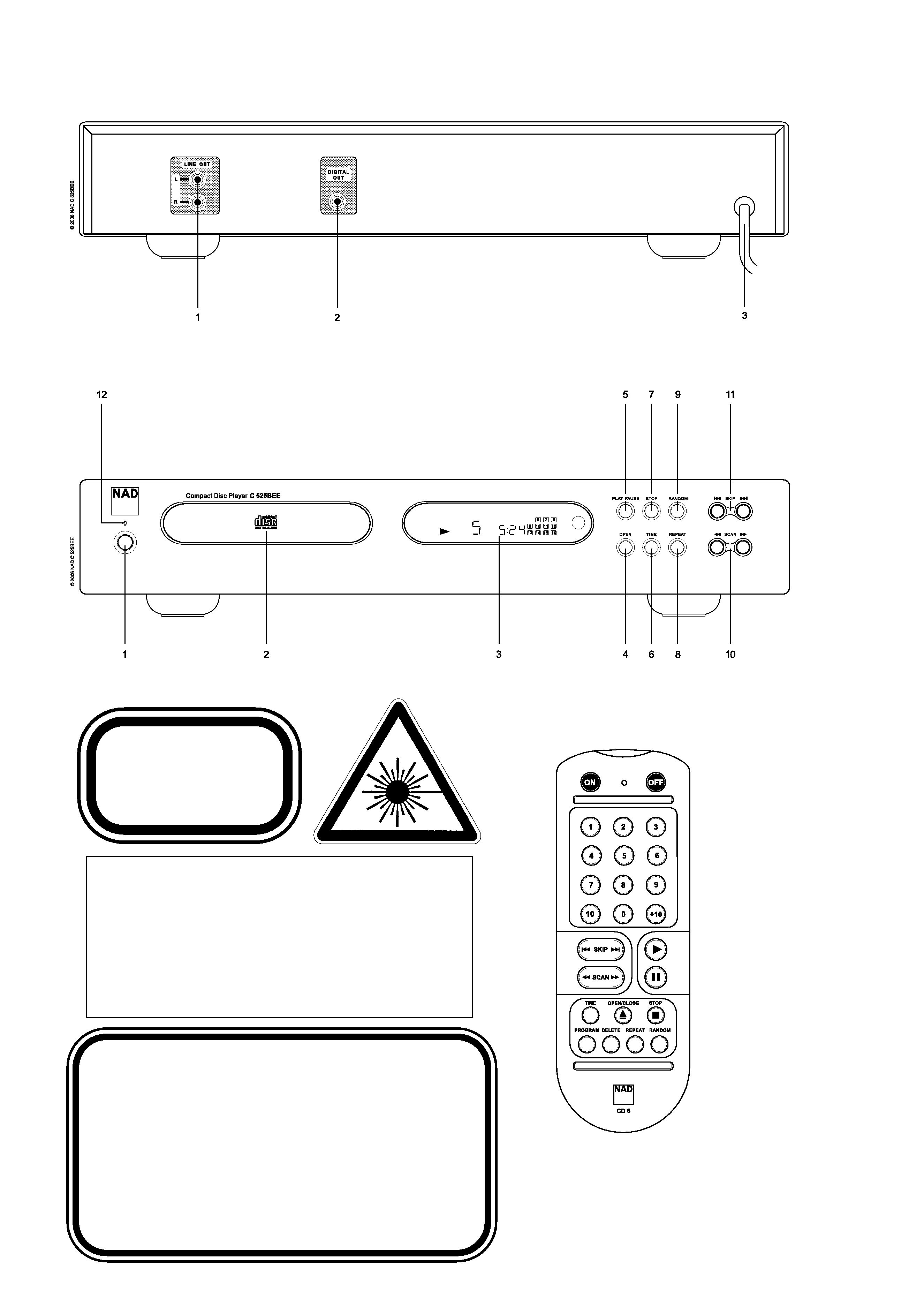
3
FRONT PANEL CONTROLS
REMOTE CONTROL
REAR PANEL CONNECTIONS
CLASS 1 LASER product
LUOKAN 1 LASERPLAITE
KLASS 1 LASERAPPARAT
THIS DIGITAL APPARATUS DOES NOT EXCEED THE CLASS B LIMITS
FOR RADIO NOISE EMISSIONS FROM DIGITAL APPARATUS AS SET OUT
IN THE RADIO INTERFERENCE REGULATIONS OF THE CANADIAN
DEPARTMENT OF COMMUNICATIONS.
LE PRESENT APPAREIL NUMVERIQUE N'EMET PAS DE BRUITS
RADIOELECTRIQUES DEPASSANT LES LIMITES APPLICABLES AUX
APPAREILS NUMERIQUES DE LA CLASSE B PRESCRITES DANS LE
REGLEMENT SUR LE BROUILLAGE RADIO ELECTRIQUE EDICTE PAR LE
MINISTERE DES COMMUNICATIONS DU CANADA.
WARNING! INVISIBLE LASER RADIATION WHEN OPEN AND INTERLOCKS DEFEATED.
AVOID EXPOSURE TO BEAM.
VORSICHT! UNSICHTBARE LASERSTRAHLEN TRITT AUS, WENN DECKEL GEÖffnet und
wenn sicherheitsverriegelung ÜberbrÜckt ist. Nicht dem strahl aussetzen.
ADVARSEL - USYNLIG LASERSTRÅLING VED ÅBNING, NÅR SIKKERHEDSAFBRYDERE ER
UDE AF FUNKTION.UNDGÅ UDSÆTTELSE FOR STRÅLUNG.
ADVARSEL - USYNLIG LASERSTRÅLING NÅR DEKSEL ÅPNES OG SIKKERHEDSLÅS
BRYTES. UNNGÅ EKSPONERING FOR STRÅLEN.
VARNING - OSYNLIG LASERSTRÅLNING NÄR DENNA DEL ÄR ÖPPNAD OCH SPÄRRAR ÄR
URKOPPLADE. STRÅLEN ÄR FARLIG.
VARO! - AVATTAESSA JA SUOJALUKITUS OHITETTAESSA OLET ALTTIINA
NÄKYMÄTÖNNTÄ LASERSÄTEILYLLE. ÄLÄ KATSO SÄTEESEEN.
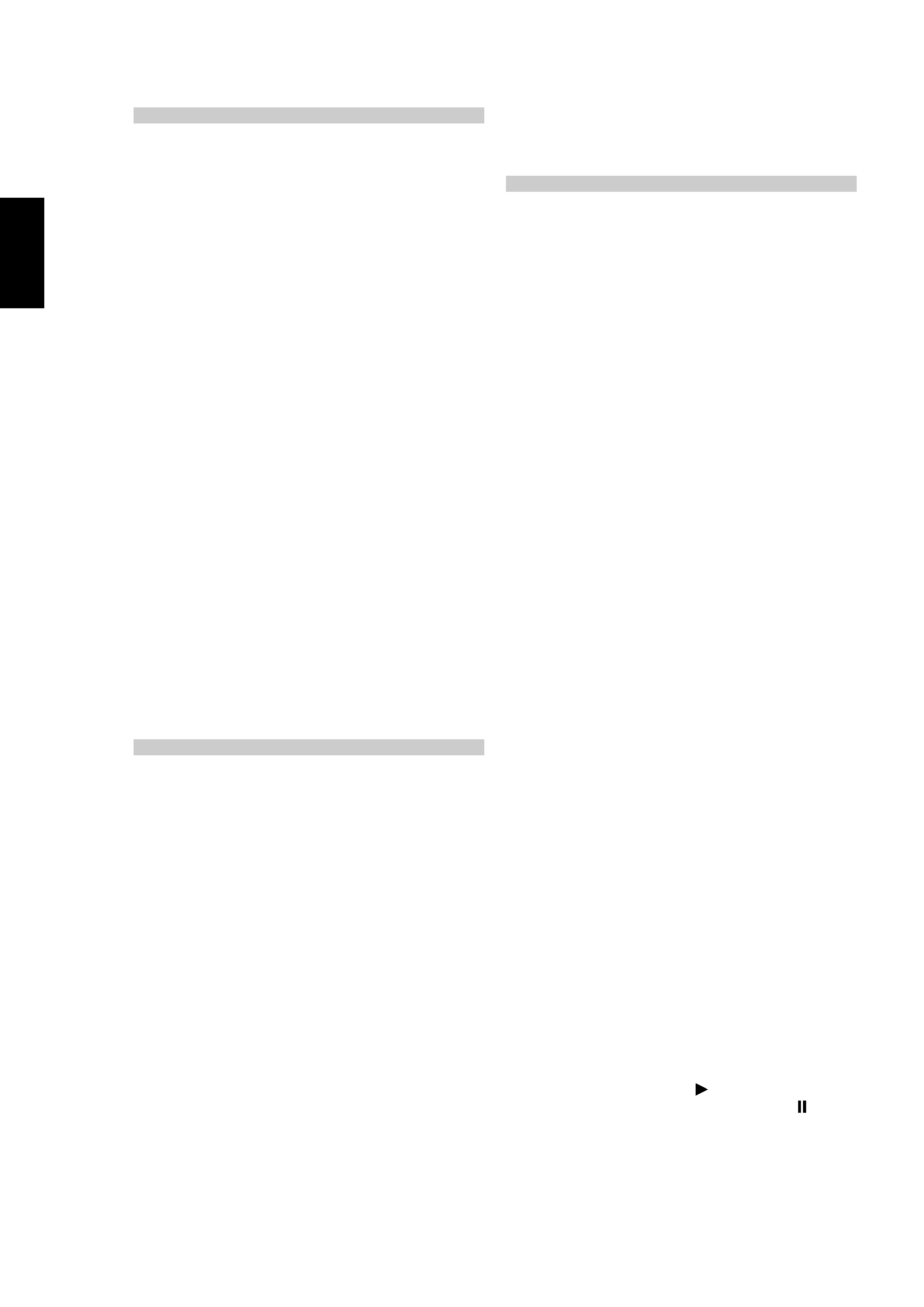
ENGLISH
FRANÇAIS
DEUTSCH
ESP
AÑOL
IT
ALIANO
POR
TUGUÊS
SVENSKA
4
QUICK START
1 Connect a twin RCA-to-RCA lead from the L (left) and R (right) Line
Output jacks to the corresponding CD inputs on your amplifier.
2 Plug in the AC power cord.
3 Press the POWER button to turn on the player.
4 Press OPEN to open the disc drawer.
5 Place a CD, label side up, in the tray's circular recess. Be certain that
the disc is centred within the recess.
6 Press PLAY/PAUSE. The drawer closes automatically, and the disc
begins to play.
7 At any time you may press SKIP to select different tracks on the
disc.
8 Press PLAY/PAUSE if you want to stop play temporarily while keeping
the pickup at its current position on the disc. Press PLAY/PAUSE again
when you want to resume playback. Press STOP if you want to end
play and reset the pickup to the beginning of the disc.
NOTE ON INSTALLATION
Install the NAD
Compact Disc player on a level, vibration-free
surface. (Severe vibration, or operation in a tilted position, may cause
the player to mis-track.) The player may be stacked with other stereo
components, as long as there is adequate ventilation around it. If the
player is placed in close proximity to a radio tuner (AM or FM), a VCR,
or a television set, the operation of its digital circuits may produce static
that would interfere with reception of weak broadcast signals. If this
occurs, move the CD player away from other devices or switch it off
when viewing or listening to broadcasts.
REAR PANEL CONNECTIONS
1. LINE OUTPUT
Connect a cable from these jacks to your amplifier. Plug one end of a
twin RCA-to-RCA lead into the L (upper) and R (lower) output jacks.
Connect the other end of the cable to your stereo amplifier's CD input,
or to any other "line-level" input jacks (such as the AUXiliary inputs). Do
NOT connect this cable to the amplifier's PHONO input jacks. The RCA
sockets on your NAD
are colour coded for convenience. Red
and White are Right and Left audio respectively, and yellow for Digital
Out. Ensure that leads and sockets are not damaged in any way and all
sockets are firmly pushed home.
2. DIGITAL OUTPUT
The digital playback signal is available at this output jack. The serial data
output is taken after the error correction but before the digital-to-
analogue conversion and filtering. The output is transformer-isolated
from the built-in D-to-A circuits. It may be connected to any digital
signal processor that conforms to the Sony/Philips (SPDIF) standard.
To use the digital output, connect a cable from this jack to the "CD
Digital" or equivalent input on a digital processor or recorder. For best
results, the cable should be a 75 ohm coaxial cable of the type used for
video signals, with an RCA phono plug at each end. (To distinguish them
from similar phono-plug cables used for analogue audio signals, video
and digital signal cables often are colour-coded with yellow plugs.)
3. AC LINE CORD
Connect this power cord to an AC mains wall outlet or to an AC
convenience outlet at the rear of your amplifier.
FRONT PANEL CONTROLS
1. POWER ON/OFF
Press this button to switch on the power to the disc player. Press again
and release to switch the power off. The display will light up to indicate
the unit is switched on and ready for use.
2. DISC DRAWER
To play a disc, press the OPEN button to open the disc drawer. Place the
CD within the large circular recess in the drawer, with its transparent
playing surface facing down. The label must face UP. CD-3 discs (3-inch
CD "singles") can be played without the aid of an adapter. Place the disc
in the drawer, centered in the smaller circular recess, with its label facing
UP.
NOTE: This player was not designed to accommodate a "damping disc"
placed on a CD, nor two CDs stacked together. It plays audio CDs and
CD-RW, but not discs identified as CD-V, DVD, CD-I, CD-ROM, or
PHOTO CD. Refer also to chapter "A note on CD-R and CD-RW audio
discs"
3. DISPLAY
The display provides information about playback status and about the
optical pickup's location on the disc. The displayed track/time information
is obtained by reading inaudible "sub-codes" in the disc.
TRACK NUMBER Each disc is segmented into numbered tracks when
the recording is made; typically each numbered track will correspond to
a different song, symphonic movement, etc. These track numbers are
identified on the CD package and are encoded in the disc by its
manufacturer. In some CDs, at the manufacturer's option, tracks may be
sub-divided into sections identified by Index numbers. This player does
not display Index numbers.
TIME Normally this display shows the time elapsed since the beginning
of the current track. Using the TIME button you can switch the display
to show the remaining number of tracks and playing time to the end of
the disc. When you load a different disc and use the OPEN button
(No. 4) to close the disc drawer, the display shows the number of tracks
and the total playing time of all the tracks on the disc.
REMAIN REMAIN lights up in the lower-left corner of the display if you
have pressed the TIME button to show the remaining number of tracks
and time of the disc.
REPEAT 1 "REPEAT" and "1" light up respectively in the centre and
upper-left corner during repeat-play of a single track. "REPEAT" and
"ALL" light up during repeat-play of the entire program or disc
RANDOM When the
random mode has been selected,
"RANDOM" will be shown in the Display Panel.
CALENDAR DISPLAY TRACK LISTING Displays a list of tracks available
on the disc. As each track is played its number is blanked out on the
Track Listing, giving a simple indication of how much of the disc has
been played and how much remains. The number for the current track
being played blinks. The display shows up to 16 numbered tracks.
MEMORY During Program Play or programming for Program Play,
MEMORY will light up.
STATUS A right-pointing arrowhead
, located near the left edge of
the time display, lights up during PLAY. Two vertical bars
indicate
that the player is in PAUSE. In STOP mode the display reverts to showing
the total number of tracks and playing time of the disc.
no dISC When no disc is present or when you load a disc that cannot
be read (because it is dirty or is upside-down) "no dISC" lights up in the
display.
C 525BEE
C 525BEE
C 525BEE's
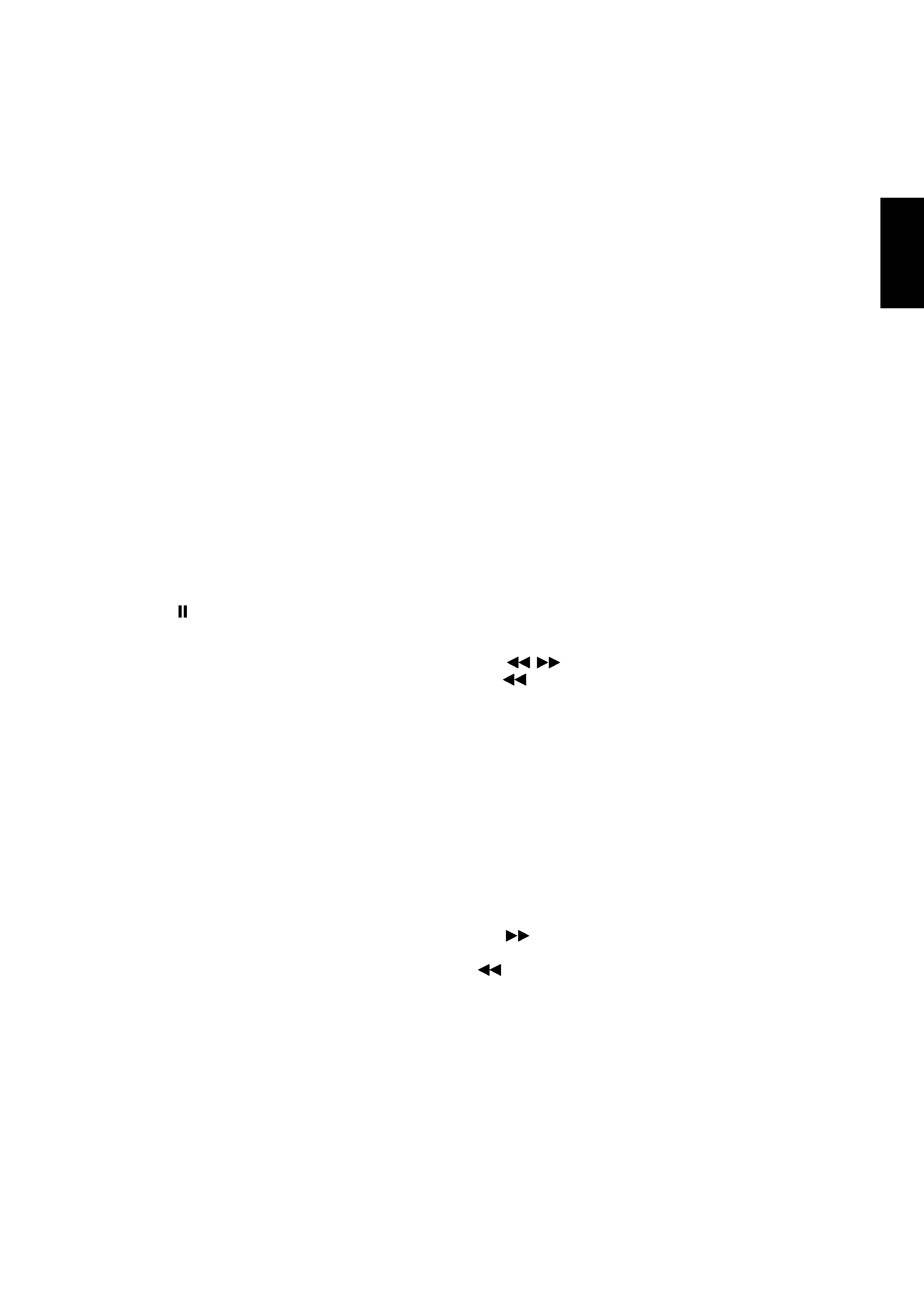
5
ENGLISH
FRANÇAIS
DEUTSCH
ESP
AÑOL
IT
ALIANO
POR
TUGUÊS
SVENSKA
REMOTE RECEIVER An infrared sensor, located at the right-hand
portion of the display window, receives commands from the remote
control. There must be a clear line-of-sight path from the remote control
to this window; if that path is obstructed, the remote control may not
work.
4. OPEN
Press this button to open the disc drawer, and press it again to close
the drawer. If this button is pressed while a disc is being played,
playback will stop, the pickup will reset to the beginning of the disc
and the drawer will open. Opening the drawer will also delete the
players memory for Program Play. When the disc drawer is open, the
drawer-closing mechanism can also be activated by pressing PLAY or
by gently pushing the drawer inward.
NOTE: The disc drawer is opened and closed by an internal motor. Do
not close the drawer by hand with the power off.
When the drawer closes, the player scans the disc's TOC (Table Of
Contents) and displays the total number of tracks and playing time on
the disc. If you press PLAY to close the drawer this information is
skipped, and play commences immediately at Track 1.
5. PLAY/PAUSE
This dual-function button alternates between starting and stopping
playback. Press to start play or to resume play after Pause. During play,
press this button to stop playback temporarily, keeping the optical
pickup at its current position on the disc. The PLAY mode is identified by
a right-pointing arrowhead in the display. The PAUSE mode is identified
by two vertical bars
. To resume playback at the exact point where
it stopped, press PLAY/PAUSE again. If you don't want to resume play at
the same point, you may use the SKIP and SCAN controls to cue the
pickup to a different starting point before pressing PLAY again.
6. TIME
The TIME button alternates between displaying the elapsed or
remaining tracks and time of the disc or program being played. In the
default setting, the display will indicate the current track number and
time elapsed since the beginning of the track. Press the button once to
display the total number of remaining tracks and time of the disc or
program being played. Press again to revert to the default, elapsed time
display.
7. STOP
Press the STOP button once to stop playback, and re-sets the pickup to
the beginning of the disc. The display reverts to showing the number of
tracks and total playing time on the disc. If the CD player was
programmed to play a selection of tracks, the program will be retained
in the player's memory. Pressing STOP a second time will also delete the
program. Pressing STOP twice will also disengage Repeat and Random
play if these were engaged.
8. REPEAT
This button engages the Repeat Play mode, an endless-repeat cycle.
Press the Repeat button once to select the REPEAT 1 mode, in which
only the current track is repeated over and over again. Pressing the
Repeat button once again selects the REPEAT ALL mode, in which the
entire disc is played from beginning to end, over and over again. Press
the Repeat button a third time to cancel the repeat cycle and return to
normal operation.
The Repeat Play mode can be used in combination with Program and
Random Play modes. When the
is in Repeat Play mode
"REPEAT 1" or "ALL" will be shown in the Display Panel. Repeat Play
mode can also be disengaged by pressing the STOP button twice. On
the first press of the STOP button, playback will stop, the second press
will disengage Repeat Play mode.
9. RANDOM
Engaging the Random Play mode will play all the tracks once on the CD
in a random order. From Stop, press first the RANDOM and then the
PLAY/PAUSE button to engage Random Play mode. During normal
playback the Random Play mode can also be engaged by pressing the
RANDOM button. The current track will stop playing and the first
randomly selected track will commence.
The Random Play mode can be used in combination with the Repeat
Play All mode but not with Program Play mode. When the
is
in Random mode "RANDOM" will be shown in the Display Panel. Press
the RANDOM button again to cancel Random Play mode and return to
normal Play mode. Random Play mode can also be disengaged by
pressing the STOP button twice. On the first press of the STOP button,
playback will stop, the second press will disengage Random Play mode.
10. SCAN
The SCAN
button causes the optical pickup to scan backward
through the recording at high speed. This button works only while the
player is in PLAY or PAUSE. After a STOP command, or after loading a
new disc, you must press PLAY before the scan circuit will work. If Scan
is initiated while the player is in PAUSE the scan is silent; if initiated
during PLAY the music will be heard in fragmentary form at reduced
volume as the player scans through it. For the first approximately 50
seconds of a track, scanning will be at around 3 times the speed, after
which scanning speed increases to around 15 times faster than normal
playing speed.
Use this "audible scan" to cue the player precisely to the spot where you
want to resume play. If you scan back to the beginning of the disc while
playing Track 1, the player automatically reverts to normal playback.
The SCAN
button causes the optical pickup to scan rapidly
forward through the music. The behaviour of this function is similar to
SCAN
. If you scan forward to the end of the disc while playing the
final track, the scan will stop and the Time display will show the table of
contents. (There is no "wrap-around" mode.)
C 525BEE
C 525BEE
